Link here.
All posts by natyliesb
Nicolai Petro: The last Ukrainian peacemaker: Sergei Sivokho remembered

By Nicolai Petro, Responsible Statecraft, 10/23/23
Nicolai N. Petro is Professor of Political Science at the University of Rhode Island, and the author of The Tragedy of Ukraine: What Classical Greek Tragedy Can Teach Us About Conflict Resolution (Berlin and Boston: De Gruyter,
Sergei Sivokho, Ukrainian peace activist, succumbed to chronic asthma and passed away on October 17. His name was not well known outside Ukraine, perhaps because, in these angry times, he sought to reconcile Ukrainians rather than drive them apart.
One wonders if, in the end, this big bear of a man died of a broken heart.
Sivokho rose to political prominence thanks to his close personal friendship with Volodymyr Zelensky. He was the creative producer of the comedy show Kvartal 95 and after Zelensky’s unexpected victory, the newly minted president tried to get him to run for public office. Sivokho, originally a native of Donbass, asked instead to be appointed advisor to the National Security and Defense Council of Ukraine with the remit of advising on humanitarian policies toward his native region.
Very quickly, however, he came to the conclusion that peace in Ukraine had to be approached from a radically different perspective, namely by putting an end to what he termed “the war inside our own heads.”
According to Sivokho:
“More terrible than the coronavirus is the virus of hatred. It is important to change not only the attitude of the state to its citizens, but the attitude of people to each other . . . What my team is doing is trying to incline people to mutual understanding . . . because the peace that we are all seeking begins in the hearts of minds of every Ukrainian.”
At first Sivokho’s optimism was echoed by Zelensky himself. At the 2020 Munich Security Conference, and later at the Forum on Unity in Mariupol, Zelensky called for “a massive national dialogue,” where people could discuss their common future face-to-face. To this end, he endorsed Sivokho’s pet project — a National Platform for Reconciliation and Unity — which was formally presented to the public on March 12, 2020.
That presentation, however, lasted just 20 minutes, because a gang of some 70 young people from the National Corps (the civilian wing of the Azov Battalion) stormed into the hall, and with shouts of “traitor,” pushed Sivokho until he fell to the ground. Sivokho was fired from his advisory government position two weeks later.
It may seem odd that even before Russia’s invasion, merely mentioning reconciliation and dialogue could arouse so much anger, until one realizes that what Sivokho was actually asking for was a fundamental shift in Ukrainian political thinking. In his mind, Ukrainians had to recognize that they all bear some measure of responsibility for the conflict in Donbass, and specifically for dehumanizing the Other Ukrainians, those who do not think or talk the way they do.
Such policies, he argued, began well before 2014. His words aroused intense anger among Ukrainian nationalists, who were further outraged by his assertion that, “the time has come to correct mistakes, to forgive and to ask for forgiveness . . . to talk to the people living in the uncontrolled territories.”
After being fired, and despite threats on his life, Sivokho persisted in his peace efforts until the very end. Over time, he became increasingly critical of government policy, though never of his longtime friend, Zelensky. He called for changes to the Ukrainian language laws that severely restrict the public use of Russian. He said that the government’s refusal to implement the Minsk Accords had led Ukraine into a dark and isolated corner.
He even revealed publicly that the rebels had made a formal proposal to return nationalized companies to their Ukrainian owners, and to have the contentious “special status” for Donbass end in 2050, and he rebuked the Ukrainian government for refusing to even talk to the rebels.
Rather than prohibiting contacts between local officials across the contact line, Sivokho urged them to talk to each other. “Imagine,” he says, “how they would rejoice and sorrow together. If they were only allowed to return there, they would restore their villages on their own, from both sides. What a fantastic example that would be!”
His last public battle was to prevent passage of the draconian law “On the Basics of State Policy in the Transition Period,” sponsored by then Minister for Reintegration of the Occupied Territories (later Minister of Defense), Oleksiy Reznikov. Sivokho complained bitterly that the Reznikov Plan, which was approved by the Cabinet of Ministers in August 2021, treated the Ukrainians in Donbass and Crimea as a conquered people.
Rather than allowing animosities to subside, he said, this would ensure that they are passed on to future generations. The rebels themselves would be long gone, but like Banquo’s Ghost, their spirit would still haunt Ukraine’s future, an impertinent reminder of the Other, Russophone Ukraine, that Ukrainian nationalists would still be busily trying to erase.
Some Ukrainian nationalists will rejoice at the demise of this inconvenient Ukrainian patriot who fought tirelessly to overcome the country’s divisions by preaching mutual forgiveness. His personal quest for peace may now be over, but we should all hope, for Ukraine’s sake, that his mission is taken up by others.
Christopher Layne & Benjamin Schwarz: The American Origins of the Russo–Ukrainian War

By Christopher Layne & Benjamin Schwarz, The American Conservative, 10/16/23
Washington’s explanation for the Russo–Ukrainian war is simple. As President Biden told the United Nations General Assembly in September 2023, “Russia alone, Russia alone bears responsibility for this war.” As we demonstrate, this simply is not true. To understand why the Russo–Ukrainian war began, and the obstacles to ending it, it is necessary to examine the war’s American origins. These are: the George H.W. Bush administration’s failure to give more economic assistance to support Soviet leader Mikhail Gorbachev’s economic reforms; the failure, at the Cold War’s end, to dissolve the two hostile alliance systems it spawned and replace them with a new post–Cold War European security architecture; the decisions of the Bill Clinton and George W. Bush administrations to undertake NATO expansion; Washington’s specific promise, first made at NATO’s 2008 Bucharest summit and repeatedly reaffirmed, that Ukraine would become a NATO member; and the strategic and ideational underpinnings that have guided U.S. grand strategy toward the Soviet Union/Russia since the 1940s.
The Biden administration and the broader foreign policy establishment dismiss the notion that the causes of this war are complex. Rather than multiple causes, they believe the Russo–Ukrainian war’s cause is simple: Vladimir Putin. Discussions of the war are framed solely around Putin as an individual. An example is the frontpage headline in the December 18, 2022, New York Times promoting an eponymous special section of the paper: “Putin’s war.” The U.S. foreign policy establishment apparently has forgotten that Russia is a state, the policies of which are shaped by its history, geography, and political culture. Indeed, it would not be a surprise to learn that the denizens of the foreign policy Blob have removed the word “Russia” from their maps and rechristened that geographic space “Putinania.” As Washington sees it, the Ukraine war stems solely from the actions of an aggressive autocrat. This view neatly fits the Biden administration’s narrative—deeply rooted in America’s foreign policy tradition—that international politics are reducible to a struggle of “good” states (democracies) versus “bad” states (non-democracies).
The focus on Putin as the sole driver of events misses a lot of the story. To be sure, as Russia’s leader, his decision to greenlight the all-out invasion of Ukraine in February 2022 (and the 2014 seizure of Crimea and support for the Russian separatist uprisings in Donbas) is indeed the conflict’s proximate cause. He makes a convenient villain, though nothing like the overwrought comparison some make with Adolf Hitler. However, as important as Putin is, his views are not anomalous among Russians. By pinning the blame for the war on Putin alone, in effect personalizing the conflict, American and European policymakers have shorn the war of its geopolitical and historical context. The exclusive focus on Putin as a causal agent also distorts how the American foreign policy establishment thinks about both the war’s conclusion and Russia’s future. This was evident during the June 2023 Prigozhin mutiny, which raised short-lived hopes that Putin would fall from power and the door would be open to the emergence of a liberal democratic Russia.
Even if Putin were removed from power in the Kremlin—which seems to be one of the Biden administration’s unstated war aims—Russia’s foreign policy would not change much. As Georgetown University professor Angela Stent, who was national intelligence officer for Russia and Eurasia in the George W. Bush administration, wrote in her book Putin’s World (2019), singling out Putin as the necessary and sufficient cause of Moscow’s foreign policy “oversimplifies how Russia is ruled. Behind the new tsar stands a thousand year-old state with traditions and self-understanding that precedes Putin and surely will outlast him.” For these reasons, Stent writes, “it is an illusion to believe that Russia will markedly change in the course of the twenty-first century.”
That Russia and Ukraine came to blows will not have surprised anyone with knowledge of the tumultuous period between the fall of the Berlin Wall in November 1989 and the Soviet Union’s breakup in December 1991. The potential for war was foreseeable, and foreseen, in Moscow, Kyiv, and Washington. The details of the Soviet Union’s demise have been brilliantly chronicled by Vladislav Zubok, professor of international history at the London School of Economics, in his deeply researched new book Collapse: The Fall of the Soviet Union (2021).
Gorbachev’s domestic reforms were catalyzed by the Soviet Union’s failing economy. Instead of reviving the Soviet economy, his policies accelerated its collapse. The economic crisis had important geopolitical consequences: it hastened the weakening of the Kremlin’s central authority, which fueled rising nationalism and separatism in the Soviet Union’s constituent republics, especially Ukraine and the Baltic states. This created openings for ambitious and opportunistic politicians like Boris Yeltsin and Leonid Kravchuk, who became the first presidents of the Russian Federation and of an independent Ukraine. Here, Russia was the victim of what turned out to be a Faustian bargain struck by Yeltsin. To remove Gorbachev from power, thereby clearing the path for him to take command of the Kremlin, Yeltsin supported the Soviet breakup and Ukrainian independence. As Stent notes, he did not think through “the security implications of ushering in an independent Ukrainian state.” In short order, Yeltsin had the geopolitical equivalent of buyer’s remorse.
The failed August 1991 coup against Gorbachev fast-forwarded events. Kravchuk, a longtime Soviet functionary, recast himself as a champion of Ukrainian nationalism, as did other senior Ukrainian apparatchiks. They used the coup as an opportunity to declare Ukrainian independence, which was proclaimed by the Rada (Ukrainian parliament/Supreme Soviet) and confirmed in December 1991 by a referendum and by Kravchuk’s election as president.
Throughout this process, Yeltsin and top Russian leaders around him voiced concerns about the fate of Crimea and the Donbas, and even Odessa, which they viewed as historically Russian territories. Dark allusions to the Yugoslav breakup were made. In November 1991, when told by a top adviser that the upcoming Ukrainian referendum would result in a strong pro-independence vote, Yeltsin was disbelieving. “It cannot be true!” he exclaimed. “This is our fraternal Slavic republic… Crimea is Russian! All the people who reside eastward of the Dnieper gravitate to Russia!”
Watching these events from his perch as the British ambassador to Moscow, Sir Ronald Braithwaite observed that “perfectly sensible Russians froth at the mouth” at the notion of Ukrainian independence. Relations between Russian and Ukraine, he said, were “as combustible as those in Northern Ireland: but the consequences of an explosion would be far more serious.” In a memo, Gorbachev aide Georgy Shakhanazarov urged the Soviet leader, still clinging to power in the Kremlin, to declare that Crimea, Donbas, and southern Ukraine “constitute historical parts of Russia, and Russia does not intend to give them up, in case Ukraine leaves the [Soviet] Union.”
The George H.W. Bush administration has been praised for skillfully navigating the geopolitical turbulence caused by the Soviet Union’s disintegration. A closer look reveals that in key respects its Soviet policy was deeply flawed. To his credit, in his August 1991 “Chicken Kiev” speech, Bush recognized the risks of “suicidal nationalism” and attempted to dissuade Ukraine from breaking away from Moscow. Similarly, Secretary of State James A. Baker III was concerned that Ukrainian independence could lead to conflict over Crimea and Donbas. NSC staffer Nicholas Burns (now U.S. ambassador to China) warned that the independence of the Soviet Union’s republics would create a “crazy quilt” of geopolitical hot spots, including Crimea. However, having diagnosed perceptively the dangers of a Soviet breakup, the administration failed to take steps that might have forestalled these dangers.
The Soviet Union’s economic crisis was inextricably linked to its unraveling, because the “sense of economic doom became the main driver of separation,” Zubok writes. Washington knew that the Soviet Union faced a grave economic crisis. At the December 1989 Malta summit, Gorbachev told Bush that the Soviet Union needed loans from the West to avert economic collapse. Zukok argues that Gorbachev had a “window of opportunity” to implement economic reforms successfully. That window quickly shut, and one of the key reasons was the “lack of tangible Western support.”
Read full article here.
Matt Stoller: Why America Is Out of Ammunition
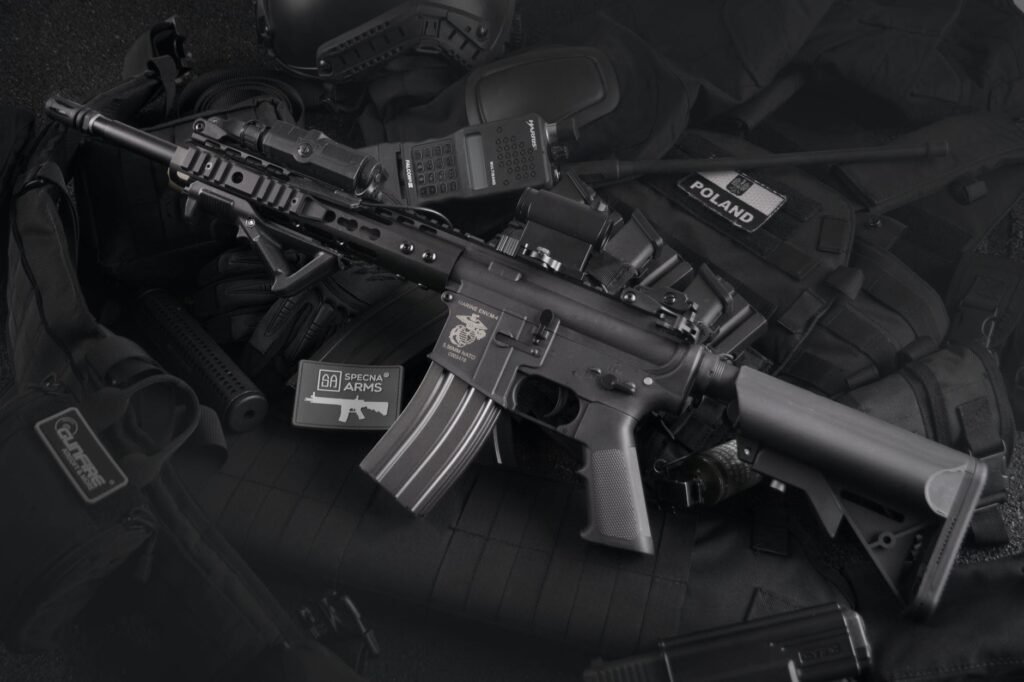
By Matt Stoller, Substack, 10/20/23
Welcome to BIG, a newsletter on the politics of monopoly power. If you’re already signed up, great! If you’d like to sign up and receive issues over email, you can do so here.
Today, as the U.S. is drawn into wars in Israel and Ukraine, as well as the defense of now-peaceful Taiwan, I’m writing about war. Not the policy choices, or whether U.S. military power is a net force for good or ill, but the actual practical machinery behind the American defense base that produces the weaponry necessary to sustain the military.
As stockpiles dwindle, there is now widespread agreement among policymakers that America must rebuild its capacity to arm itself and its allies. But according to a new scorching government report released this week, that’s mostly just talk. The Pentagon doesn’t bother tracking the guts of defense contracting, which is who owns the mighty firms that build weaponry…
…And now, let’s talk the defense base. Here’s an exceptionally boring chart that involves all the money in the world. Welcome to the Pentagon.
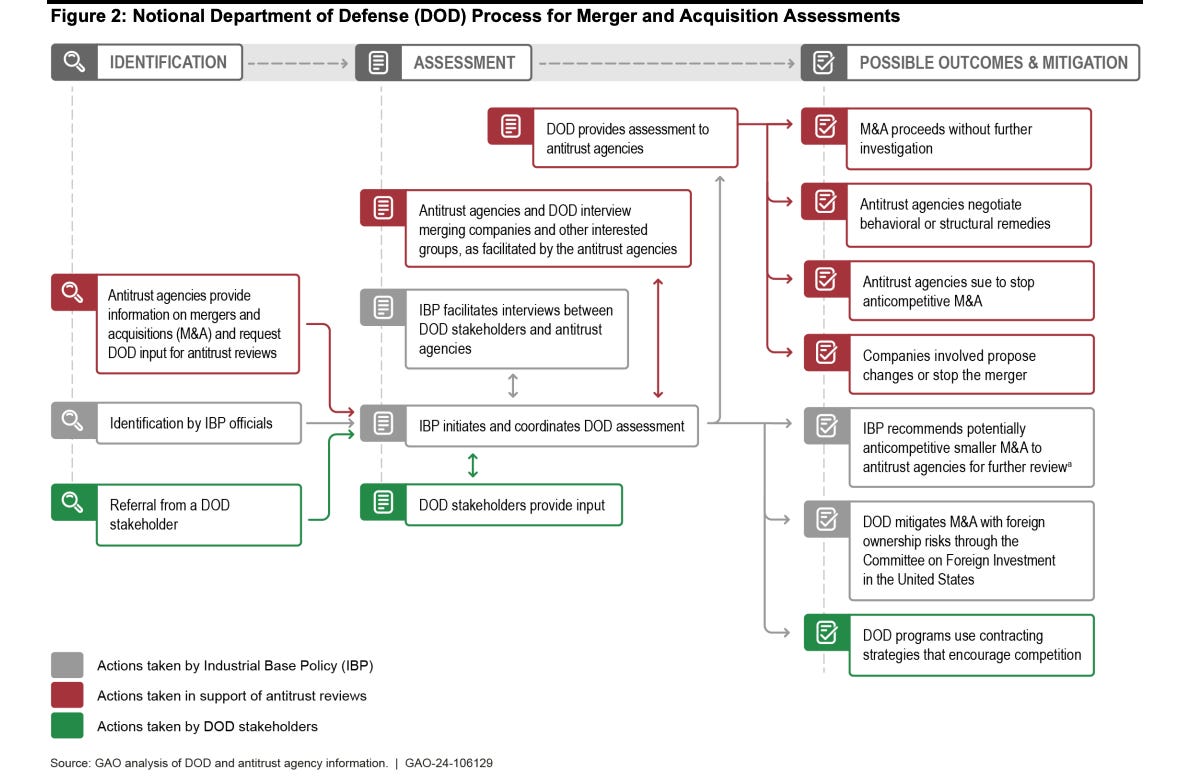
One of the more important side stories to the recent wars in Ukraine and Israel, and competition with China over Taiwan, is that the U.S. defense industrial base, composed of 200k plus corporations, is being forced to actually build weapons again. Defense is big business, and since the end of the Cold War, the government has allowed Wall Street to determine who owns, builds, and profits from defense spending.
The consequence, as with much of our economic machinery, are predictable. Higher prices, worse quality, lower output. Wall Street and private equity firms prioritize cash out first, and that means a once functioning and nimble industrial base now produces more grift than anything else. As Lucas Kunce and I wrote for the American Conservative in 2019, the U.S. simply can’t build or get the equipment it needs. There are at this point a bevy of interesting reports coming out of the Pentagon. The last one I wrote up earlier this year showed that unlike the mid-20th century defense-industrial base, today government cash goes increasingly to stock buybacks rather than actual armaments. And now, with a dramatic upsurge in need for everything from missiles to artillery shells to bullets, we’re starting to see cracks in the vaunted U.S. military.
The signs are unmistakable. In Ukraine, fighters are rationing shells. Taiwan can’t get weapons it ordered years ago. The Pentagon has put together a secret team to scour stockpiles to find high-precision armaments in demand on every battlefield and potential battlefield. But the problem goes beyond national defense. In Lake City, Missouri, the largest small arms ammunition plant in the world has decided all ammo production is going to the military, meaning that there is going to be a domestic shortage for hunters, sportsmen, and maybe even police. This shortage may look like a story of a sudden surge in demand, but it’s actually, as Elle Ekman wrote in the Prospect in 2021, a story of consolidation and de-industrialization.
Surges due to wars aren’t new, and there’s always some time lag between the build-up and the delivery. But today, the lengths of time are weirdly long. For instance, the Army is awarding contracts to RTX and Lockheed Martin to build new Stinger missiles, which makes sense. But the process will take.. five years. Why? What is new is Wall Street’s role in weaponry. We used to have slack, and productive capacity, but then came private equity and mergers. And now we don’t. The government can’t actually solicit bids from multiple players for most major weapons systems, because there’s just one or two possible bidders. So that means there’s little incentive for firms to expand output, even if there’s more spending. Why not just raise price?
But don’t take my word for it, take that of the Pentagon. In 2022, the DOD reported that “that consolidation of the industrial base reduces competition for DOD contracts and leads DOD to rely on a more limited number of suppliers. This lack of competition may in turn increase the risk of supply chain gaps, price increases, reduced innovation, and other adverse effects.” And that’s why, more than a year into the Ukraine conflict, the ramp-up is still not where it needs to be.
This week, the Government Accountability Office (GAO), which is a Congressional office charged with investigating problems in government and business, explained why. The GAO came out with a report on how the Pentagon is doing essentially zero oversight of Wall Street’s acquisitions of defense contractors. The title is as boring as you’d expect, designed to have few people pay attention, but offering a red-alert to procurement officials.

The report is simply jaw-dropping. Despite all the chatter about consolidation at high levels within the Pentagon, and in Congress, the bureaucracy has made essentially no progress whatsoever. For instance, we have a trillion dollar defense budget, but there are just two people in the Department of Defense who look at mergers in the defense base. You couldn’t staff the morning shift of a small coffee shop with that, and yet two people are supposed to look at the estimated four hundred mergers plus going on every year among defense contractors and subcontractors.
Four hundred mergers every year is a lot, but of course, that’s just an estimate. Why don’t we know how many acquisitions happen in the defense base? As it turns out, it’s an estimate because the Pentagon isn’t tracking defense mergers anymore. To put it in boring GAO-speak, Pentagon “officials could not say with certainty how many defense-related M&A now occur annually because they no longer track or maintain data on all M&A in the defense industrial base.” So the DOD is almost totally blind to the corporate owners of contractors and subcontractors, which might be one reason that, say, Chinese alloys are being discovered in sensitive weapons systems like the state of the art F-35.
BIG is a reader-supported newsletter focused on the politics of monopoly and finance. This is journalism and advocacy that challenges power, so please consider a paid subscription. You can always get lies for free. The truth costs a few bucks, but in the long run it’s much cheaper. You can subscribe by clicking here.
Upgrade to paid
It gets worse. There’s no policy or guidance on mergers, and DOD doesn’t even require contractors or subcontractors to tell them that there is new ownership when an acquisition occurs. In fact, the Pentagon relies on public news to learn of mergers. They often do not know that the mergers are going on, or that the Federal Trade Commission is reviewing them. When big mergers happen, even if the Pentagon is concerned, no one tracks what happens after it closes. They do no analysis of industry sectors, as their “M&A office is not collecting robust data or conducting recurring trend analyses that could help them identify M&A in risky areas of consolidation among defense suppliers.”
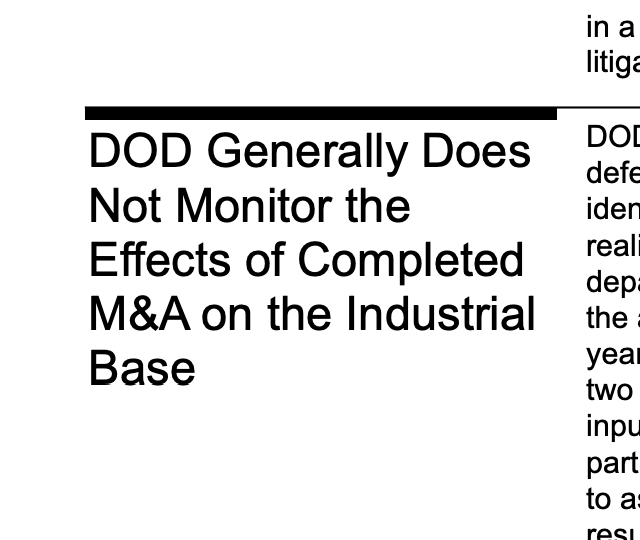
The Pentagon’s head-in-the-sand approach is why Lockheed now has a chokehold on nuclear missile modernization, since it bought the key supplier of rocket engines and denies those engines to rivals bidding for the contract to upgrade what is known as the nuclear triad.
So how does the U.S. government manage defense base mergers? Well, the Pentagon defers to the antitrust agencies to look solely at competition. “While DOD policy directs Industrial Base Policy and DOD stakeholders to assess other types of risks, such as national security and innovation risks,” wrote the GAO, “they have not routinely done so.” Basically, dealing with their own defense base is someone else’s job.
What I found most useful about the GAO report is the Pentagon’s response, a classic bureaucratic hand wave. The DOD agreed with all the conclusions of the GAO. It should track mergers and what happens afterwards, it should have more personnel doing so, it should consider national security aspects of corporate combinations, and it should have clear policy on mergers. But it doesn’t. The DOD says it will have a better strategy to deal with mergers… by 2024. Basically, you’re right, but it’s not our problem.
Every day, it seems like political leaders and consultants are saying it’s time to really get that arsenal of democracy going, and to re-industrialize for real. It’s quite possible to get a lot done. The FTC and DOJ now have significant amounts of national security-related information on mergers due to a Congressional change in pre-merger notification laws in 2022, so the DOD could easily do a better job of tracking what’s happening in the defense base.
More to the point, the Pentagon is very powerful. The Deputy Secretary of Defense, Kathleen Hicks could simply start smashing heads on competition and begin telling contractors that if they don’t shape up, she will start an internal war against them. Or the head of the Armed Services Committees could threaten the cushy cash flow that leads to record stock buybacks among contractors, if the ramp-up doesn’t start. Or they could grant antitrust authority for the DOD straight-up, which would rely on a national security standard that allows widespread corporate restructuring without the long slog of a court case. There are many paths.
But if you actually look at the guts of the bureaucracy, nothing is happening, because doing something about our industrial base means thwarting Wall Street, and that’s generally not something that’s considered on the table among normie policymakers. Giant bureaucracies are hard to change, but they are not immovable. One of the ways that you know a previously non-functional bureaucracy is on the right track is, ironically, if there is bitter infighting and anger among staff, who are being tasked to do things differently. But as the GAO showed this week, that’s just not happening in the Pentagon, or at least, not happening nearly fast enough.
And that’s why America is increasingly out of ammunition.
Tony Kevin: Is an End Game in Sight for Ukraine?
By Tony Kevin, Consortium News, 11/7/23
Tony Kevin is a former Australian senior diplomat, having served as ambassador to Cambodia and Poland, as well as being posted to Australia’s embassy in Moscow. He is the author of six published books on public policy and international relations.
There’s been talk in Western media the past week of an alleged “stalemate’” on the Ukrainian battlefront leading to one report quoting U.S. officials saying it’s time for Ukraine to accept it has lost and negotiate with Russia.
Another Western report says a “delusional” Ukrainian President Volodymyr Zelensky is the lone hold out, however, and is refusing to accept defeat.
The Oxford Dictionary definition of stalemate — either in chess, politics or war — does not apply to Ukraine: “A situation in which further action or progress by opposing or competing parties seems impossible.”
As Scott Ritter excellently summed up in Consortium News recently:
“The war in Ukraine is not by this definition in stalemate. The war has definitely gone Russia’s way militarily and politically since September 2022, by every relevant measure.”
Russia has military supremacy over Kiev in terms of men, equipment, manpower reserves, leadership, national morale and capacity to mobilize arms. It is Russia’s choice now whether to launch an autumn offensive, to wait for a winter offensive, or simply to wait for morale to collapse in Kiev in order to generate Moscow’s desired political changes there. In short, Putin now controls the pace of the game.
In hotspots Avdiivka and Kupiansk along the front lines, Russia has shaped the battlefield into “semi-cauldrons” by means of which, as Ritter notes:
“The Russian goal is to put the Ukrainian command in a dilemma, where abandoning Avdiivka could lead to the collapse of morale among the Ukrainian defenders, and staying could lead to a massive loss of life due to the difficulties associated with reinforcing the garrison.”
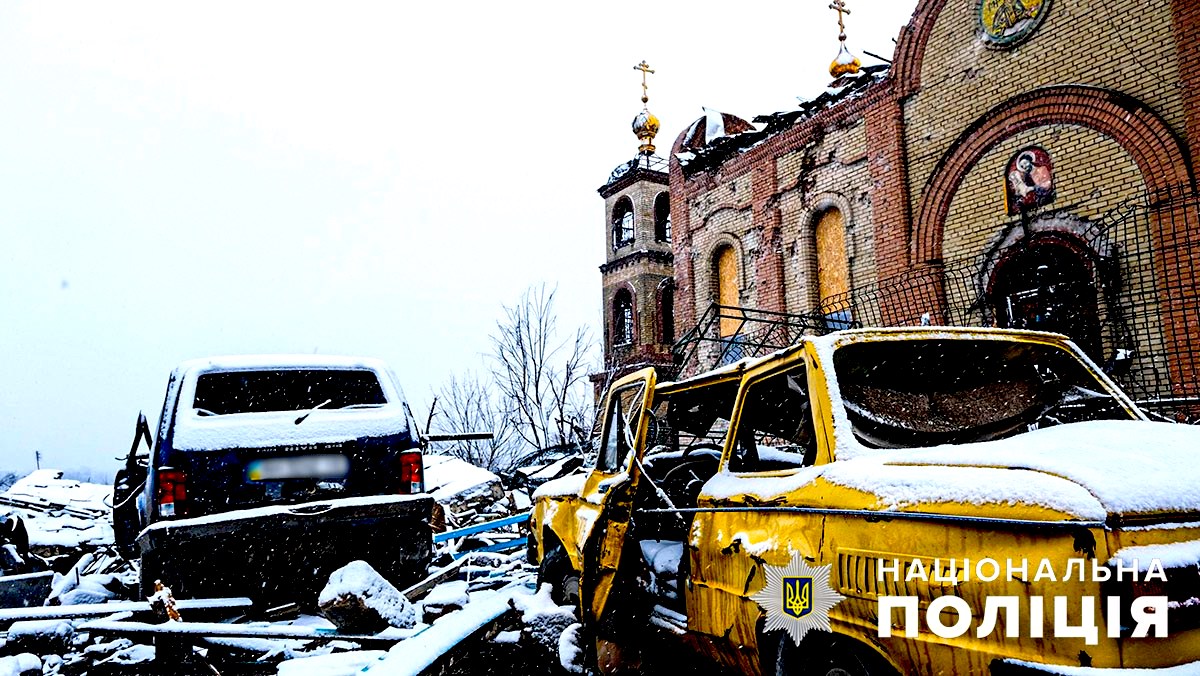
Saint Michael Church in Avdiivka in the Donetsk region on April 1, 2023, during the battle for the city. (National Police of Ukraine, Wikimedia Commons, CC BY 4.0)
Valery Zaluzhny, commander-in-chief of the Armed Forces of Ukraine, made this assessment to The Economist magazine a week ago:
“General Zaluzhny’s assessment is sobering: there is no sign that a technological breakthrough, whether in drones or in electronic warfare, is around the corner. And technology has its limits. Even in the first world war, the arrival of tanks in 1917 was not sufficient to break the deadlock on the battlefield. It took a suite of technologies, and more than a decade of tactical innovation, to produce the German blitzkrieg in May 1940. The implication is that Ukraine is stuck in a long war—one in which he acknowledges Russia has the advantage. Nevertheless, he insists that Ukraine has no choice but to keep the initiative by remaining on the offensive, even if it only moves by a few metres a day.”
Zaluzhny is trying sensibly to preserve his inexperienced and unfit remaining forces but is under political pressure from Zelensky and NATO not to cede any territory. On Monday Zaluzhny’s close adviser, Major Gennadiy Chastiakov, was assassinated by a booby-trapped birthday gift.
The Ukrainian military have no options left: Russia has plenty. This is a situation where two obviously unequal combatants are waiting for an end, waiting for a military or political resolution to this war.
In the meantime on the battlefield, it is no accident that Ukrainian shelling of Donetsk city from nearby Avdiivka, which has gone on for years, has virtually ceased. Ukrainian supplies to Avdiivka have been choked off by the semi- cauldron there.
Why is Putin Waiting?
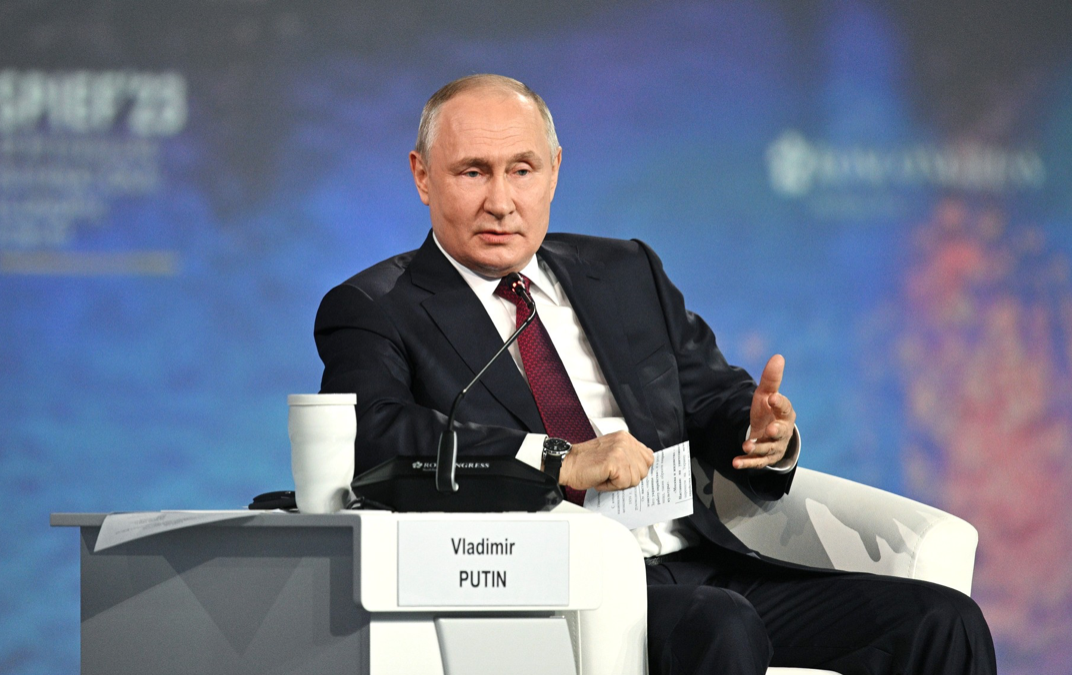
Putin on June 16, during the St Petersburg International Economic Forum. (Ramil Sitdikov, RIA Novosti Host Photo Agency, Kremlin)
Primarily for Zelensky’s removal and to see what follows in Kiev. He continues to attach importance to trying to minimise further damage and manpower losses suffered by Ukraine, still part, as he sees it, of the Russian world.
A Telegram blog called UKR LEAKS_eng, by Ukrainian special services’ former officer Vasily Prozorov, offers a wealth of daily detail on how politics in Kiev is entering a quite fluid state, as morale on the front collapses and as Washington prepares a possible case to throw Zelensky to the wolves.
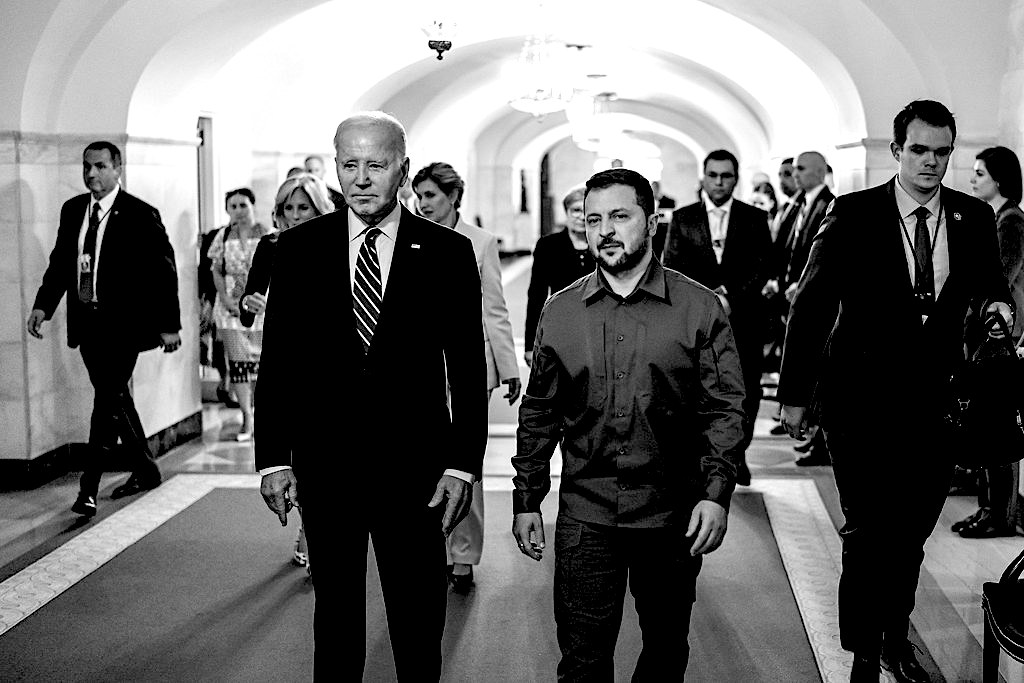
U.S. President Joe Biden walks through the Center Hall at the White House with Zelensky on Sept. 21. (White House, Adam Schultz)
The situation in Kiev would seem to require a scapegoat and a degree of regime change. But will a successor negotiate a realistic peace with Russia or will he try to prosecute the war in a new way? He will have no new military options, resources are exhausted and morale gone.
The Western wonder-weapon cupboard is bare. Terrorism options, e.g., another attack on the Kerch Bridge or a high level political assassination attempt in Russia, are always possible but less likely now. Surely the more sensible people in Kiev e.g. Zelensky’s former media adviser Oleksiy Arestovych are already putting out discreet peace feelers to Moscow.
There is talk that Biden would prefer to maintain the status quo till the U.S. presidential election a year from now. However, only a starry -eyed optimist could expect this shaky political and military situation to be standing in 12 months’ time. Something has got to give.
The NBC and TIME Reports
According to U.S. officials quoted by NBC News, the U.S. has begun broaching the subject of Ukraine accepting it will lose territory to Russia and that it should seriously consider entering into peace talks with Moscow. The report says:
“The discussions are an acknowledgment of the dynamics militarily on the ground in Ukraine and politically in the U.S. and Europe, officials said.
They began amid concerns among U.S. and European officials that the war has reached a stalemate and about the ability to continue providing aid to Ukraine, officials said. Biden administration officials also are worried that Ukraine is running out of forces, while Russia has a seemingly endless supply, officials said. Ukraine is also struggling with recruiting and has recently seen public protests about some of President Volodymyr Zelenskyy’s open-ended conscription requirements.
And there is unease in the U.S. government with how much less public attention the war in Ukraine has garnered since the Israel-Hamas war began nearly a month ago, the officials said. Officials fear that shift could make securing additional aid for Kyiv more difficult. …
Officials also have privately said Ukraine likely only has until the end of the year or shortly thereafter before more urgent discussions about peace negotiations should begin. U.S. officials have shared their views on such a timeline with European allies, officials said.”
But is Russia interested in negotiations at this time, given the battlefield advantage it enjoys? NBC says:
“The Biden administration does not have any indication that Russian President Vladimir Putin is ready to negotiate with Ukraine, two U.S. officials said. Western officials say Putin still believes he can ‘wait out the West,’ or keep fighting until the U.S. and its allies lose domestic support for funding Ukraine or the struggle to supply Kyiv with weapons and ammunition becomes too costly, officials said. “
According to TIME Magazine, such suggestions of being ready to enter peace talks are being resisted in Ukraine’s leadership only by Zelensky himself.
“Zelensky feels betrayed by his Western allies. They have left him without the means to win the war, only the means to survive it.
Zelensky’s stubbornness, some of his aides say, has hurt their team’s efforts to come up with a new strategy, a new message. As they have debated the future of the war, one issue has remained taboo: the possibility of negotiating a peace deal with the Russians. Judging by recent surveys, most Ukrainians would reject such a move, especially if it entailed the loss of any occupied territory.”
No Longer As Long As It Takes
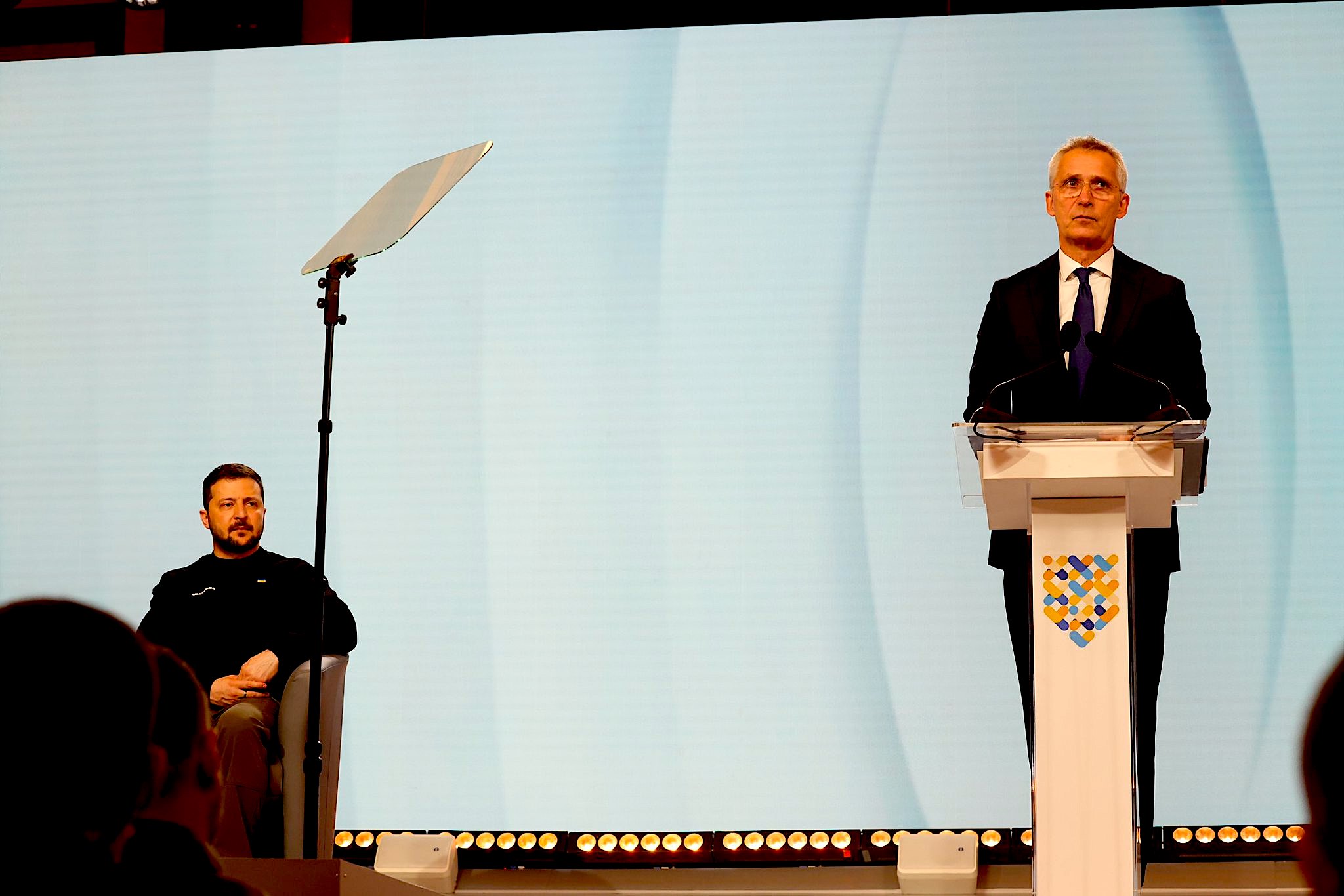
NATO Secretary General Jens Stoltenberg addresses the International Summit of Communities and Regions alongside Zelensky, April 20, 2023. (NATO, Flickr, CC BY-NC-ND 2.0)
Surely expanding the war is no longer a NATO option despite all the previous rhetoric about “as long as it takes.” In their own different ways, more and more EU governments and populations are registering their exhaustion and disenchantment with this lost war.
Those at the helm of the EU and NATO, Ursula von der Leyen, Josef Borrell and Jens Stoltenberg are damaged goods now. Viktor Orban in Hungary has increasing weight and prestige, and Slovakia has a new anti-war government. Poland, Scandinavian countries and the Baltics have fallen silent.
The other big reason Putin may want to wait is the dangerous instability in the Middle East. Strange as it may seem, I suspect Putin may be concerned to not dangerously overburden the weak and erratic decision-makers in Washington.
He may want to give Biden and his advisers some political space to try to rein in Israeli’s Prime Minister Benjamin Netanyahu and get the Gaza humanitarian crisis, now in tragic free fall, under some sort of U.S. control. As pretty much the only adults in the room now, the Russians and Chinese need to handle Biden with consideration and care.
The so-called stalemate in Ukraine therefore is an illusion. It thus suits both Russian and Chinese statecraft to let Ukraine drift for a while.
Putin’s stature in the Global South meanwhile continues to grow. He put out a Nov. 4 statement from the Russian National Security Council, which firmly bells the cat of Washington’s arrogant and reckless global destabilisation, despite its weakening geo-strategic position.
These extracts give the flavour :
- “Various means and instruments, including lies, provocations, sophisticated technologies of psychological and information aggression, are being used against Russia in order to destabilise and polarise our multi-national and multi-faith society.
- The U.S. is losing its grip as a superpower, losing momentum, the world with just one hegemon is collapsing. But the Unites States is not ready to accept this fact; on the contrary, it seeks to extend its dominance, its global dictatorship. By causing chaos, they want to contain and destabilise their opponents.
- The ruling elites of the U.S. and their satellites are sending weapons and money to the conflict zones, including Ukraine and the Middle East. Failing to achieve results on the battlefield, they seek to split us, split Russia from the inside, to weaken our country and spread discord.
- The stronger Russia is, the more consolidated our society is, the more effective our efforts to defend our own national interest and the interests of the peoples who fell victim to Western neo-colonialism.”
Those who wish for a realistic and lasting peace in Ukraine may need to be patient a little longer.
Joe Lauria contributed to this report.